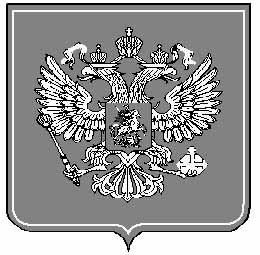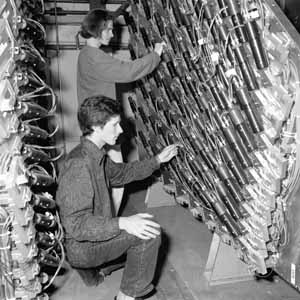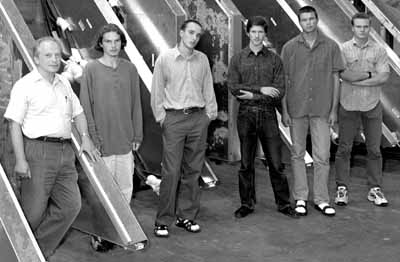 |
|
Russian Students pitch in at DZero by Kurt Riesselmann
And it can mean a trip to the other side of the world.
Five students from Russia have joined the hundreds of physicists working at Fermilab this summer. Russian scientists started visiting Fermilab in the 70s, but this marks the first time that several Russian students have joined them to work on the DZero collider experiments.
"We are very pleased to see these students joining our experiment," said Harry Weerts, co-spokesman of the DZero collaboration. "Senior Russian physicists have contributed a lot to DZero and to Fermilab. Until this summer, students have been missing from the mix. Having them at Fermilab will give them access to the unique physics potential of the Tevatron, and it will help to maintain a top physics education program at their home institutions."
Sergei Denisov, long-time DZero collaborator, worked hard to make the student's trip possible. Denisov, physics professor at Moscow State University and department leader at the Institute of High Energy Physics in Protvino, Russia, is a member of the prestigious Russian Academy of Science.
"The five students are all from Moscow State University," Denisov said. "They all attended my lectures, and they are among the best."
Alexandr Klimenko and Kirill Lugovsky are two of the five students that traveled across the world to spend their summer at Fermilab. Back home, at IHEP, they worked on scintillating counters that will be used for particle identification at the DZero experiment (see story on page 2). When scientists at IHEP shipped the counters to the United States, Denisov decided Klimenko and Lugovsky should have the chance to continue their work on the counters' assembly and installation in the DZero detector.
With help from other IHEP scientists, Klimenko and Lugovsky prepared and tested the hardware for the counters, whose main components are tiles of scintillating plastic and photosensors.
"Six layers of scintillation counters will eventually be installed in the DZero detector, three on each side of its center, perpendicular to the beam line," Klimenko explained.
Charged particles crossing the scintillating material create a short pulse of light that is detected by the sensors, creating an electrical signal. DZero physicists use these signals for triggering the readout of other detector components, like wire chambers, that determine particle tracks more precisely. The proper functioning of the scintillation counters is a crucial step in DZero's chain of data collection.
"Only 400 students per year are accepted," says Lugovsky. "Those that survive the selection process receive an MSU stipend that covers essential living expenses." When joining the program, Lugovsky said, he had no idea that his physics studies would take him to the United States.
By 1999, both Klimenko and Lugovsky had decided to specialize in high-energy physics. They continued their studies at the IHEP institute, also known as Serpukhov. It is home to a 70 GeV proton accelerator, which is used for studying quark-antiquark bound states, neutrino interactions and many other particle physics phenomena. In addition, IHEP is engaged in R&D for detector and accelerator technology.
The Russian students are the newest example in a long, strong tradition of Fermilab-Russian collaboration. The first experiment ever done at Fermilab was as a Fermilab-USSR collaboration, in the early 70s, in the depths of the Cold War. Since then, legions of Russian physicists have brought their distinctive and respected Russian style of physics to the laboratory.
The 10-percent test
Moscow State students Petr Nomokonov and Denis Zotkin spent their summer working on the DZero silicon tracker. Nomokonov helped construct the disks with silicon detectors for tracking particles in the forward direction of the DZero detector, very near the proton-antiproton collision area.
Zotkin worked on assembling the "10-percent test" located at Fermilab's Silicon Detector Facility.
"We will be testing 10 percent of the readout channels of the whole silicon tracker," Zotkin explains. "I wired up and labeled the whole high voltage system. Now I help testing readout modules. By now, I am familiar enough with the readout system as to actively help on the debugging and running."
Fermilab physicist Aurelio Juste is responsible for the 10-percent-test. He supervised Zotkin's work, and he is delighted.
"Working with Denis has been one of the best experiences this summer," says Juste. "In practice, we set up the equivalent of a small fixed-target experiment in terms of complexity and number of readout channels. That meant working late, even night and weekend shifts. Denis was a great help, and I'd love him to be a full-time member of the 10-percent test."
The 10-percent test started recording data at the end of August, and testing will continue until November. Back in Moscow, Zotkin will be able to continue working on the readout software via Internet.
Family heritage of particle physics
Zotkin comes from a family closely tied to particle physics. His father is professor at Moscow State University and works on the Zeus experiment, which uses the electron-proton collider at the German high-energy laboratory DESY.
Nomokonov's family also has a particle-physics history. He is the second member of his family working at Fermilab.
"In 1975, my father spent one and a half years at Fermilab," Nomokonov says. "He worked at the Joint Institute for Nuclear Research in Dubna, Russia. He and several of his colleagues visited Fermilab to help measuring proton-proton scattering cross sections."
The fifth Russian student at Fermilab is Andrey Kubarovsky. He works at the Computing Division, programming physics analysis tools. Like his fellow students, he spent about two months at Fermilab.
Though the summer has meant hard work and little playing time, the Russian students fondly remember the highlight of their non-physics activities.
"Professor Denisov took all of us to the Niagara Falls," Zotkin remembered with a smile. "It was wonderful!"
|
| last modified 9/15/2000 email Fermilab |
FRLsDFx9eyfrPXgV
 Summer time is prime research time. Physicists from all over the world come to Fermilab to work on their experiments. Professors and students alike enjoy the opportunity to turn their backs on the classroom and get their hands dirty turning wrenches and connecting cables.
Summer time is prime research time. Physicists from all over the world come to Fermilab to work on their experiments. Professors and students alike enjoy the opportunity to turn their backs on the classroom and get their hands dirty turning wrenches and connecting cables.
 Klimenko and Lugovsky started studying physics at Moscow State University in 1997. Each year, more than 2000 students apply for the renowned physics program at MSU. No wonder: Physicists from MSU have received a total of five Nobel Prizes.
Klimenko and Lugovsky started studying physics at Moscow State University in 1997. Each year, more than 2000 students apply for the renowned physics program at MSU. No wonder: Physicists from MSU have received a total of five Nobel Prizes.
